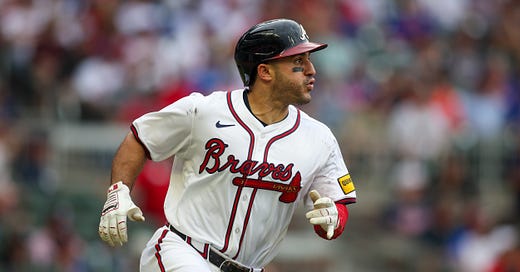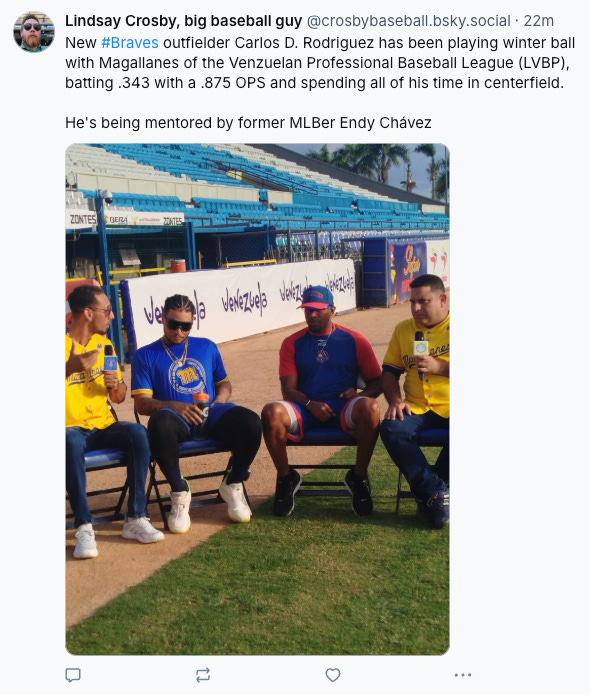News Roundup: Braves Aggressively Move On From Veterans at Non-Tender Deadline
The Atlanta Braves simultaneously added about $15M in additional salary space and five additional roster spots
Alex Anthopoulos has been aggressive this offseason…just not in the way we were expecting.
The team’s President of Baseball Operations made some significant non-tenders at last night’s deadline, continuing to subtract players we expected to return next year and freeing up additional payroll space.
The arbitration-eligibles that were non-tendered last night were outfielder Ramón Laureano, starter Griffin Canning, and pitcher Huascar Ynoa.
But the Braves also created roster spots by moving on from a few pre-arb options who were injured or wouldn’t play a major role in 2025. Ray Kerr, who had Tommy John over the summer, was non-tendered last night, as was Royber Salinas, who was claimed off waivers on November 1st.
The Braves 40-man roster currently stands at 35.
Why Atlanta moved on from Laureano and Canning
I’ll admit, I expected one of the duo of Canning or Laureano to get non-tendered, but not both. I think the money is big here: Canning was projected by MLB Trade Rumors to make $5.1M this year in arbitration, which obviously would have lessened the financial savings of Atlanta’s trade of Jorge Soler and his $13M salary for 2025. Laureano was projected for $6.1M, and as I discussed on the podcast yesterday, there were legitimate concerns that his wonderful statistical production in Atlanta (.296 batting average, .832 OPS) was a small sample size mirage given that it came with a 28.3% strikeout rate and an abysmal 3.5% walk rate.
I still think it’s odd to take on Canning in a trade just to non-tender him, but I’m going to assume that the team tried to sign him to a smaller deal and he declined. Not having any minor league options and a poor recent performance history makes it hard for a team to give you a roster spot as a #5 starter, never mind at a salary of $5M.
Ynoa’s in a similar boat to Canning - no minor league options and without almost any recent performance history due to injury, never mind a poor one. I thought they might keep him at the close-to-league minimum arbitration projection and just DFA him early if he wasn’t working out, but they obviously didn’t even want to spend that amount of money. Guessing that between the minor league performance and the medical reports they have access to, they saw something that worries them or have reason to doubt that he’d make a successful MLB return next season in a bullpen role.
So, we’ll be breaking down options for the Braves to add an outfielder and address the starting rotation on the newsletter and podcast in the coming week, now that we have some clarity on what exactly the needs are and how much money (we think) the team has to work with.
Who is Carlos D Rodriguez?
The newest member of the Atlanta Braves, of course!
The team announced that the former Brewers minor-leaguer was signed to a non-guaranteed major league deal for the 2025 season, guaranteeing him a roster spot AND guaranteeing his salary if he makes the Opening Day roster.
This one was a bit surprising - why not just sign him to a minor league deal? - but Britt Ghiroli of The Athletic reported that eighteen different teams expressed interest in signing him, so Atlanta offered a 40-man spot to sweeten the deal and seal the signing before everyone else freed up some spots.
A former international free agent in the 2017 class, the 23-year-old batted .284 in the minors last season, divided between AA and AAA, hitting only four homers but with 65 runs, 52 RBI, and 17 stolen bases in 115 games. As expected, he did most of his damage in Double-A, hitting .298 across 84 games, but struggled in his first AAA playing time of his career with a .246 average.
Given that it’s only 128 plate appearances in AAA, it’s hard to know what we can reasonably take away from Statcast, but there are some trends:
Despite the batting average struggles, he still struck out only 8.6% of the time with a 13.3% walk rate. His overall contact rate was 89% while his z-contact was 93.3%. 90th percentile exit velo was a lowly 97.2 mph, but as it’s the top ten percent of your batted ball events and he had only 100 in Triple-A, I feel comfortable throwing that out as a predictor right now - it’s clear he has below-average power from the conventional stats, but I don’t think it’s literally 20-grade on the 20-80 scouting scale.
Between the addition of Rodriguez and infielder Nick Allen, it sure feels like the Braves are adding more high-contact hitters this offseason. Is this the influence of Tim Hyers, the new hitting coach, or is it just random that the two notable adds so far are similar high-contact, low-power backups? I don’t think we know enough to definitely say for sure just yet, but it’s interesting.
Braves add two assistant coaches
Speaking of new coaches, the Braves also announced the additions of Hugh Quattlebaum and Carlos Méndez as assistant hitting coaches for Tim Hyers.
Quattlebaum, 46, joins the organization from Arizona, where he was a minor league hitting coordinator for the Diamondbacks for the last few seasons (and spent 2024 as the assistant director of hitting for the organization). Despite being the Mets interim major league hitting coach for the finish of the 2021 season, this is his first full-time position in MLB.
Méndez, 50, followed the Brian Snitker career path - he’s spent the past seventeen years in Atlanta’s minor leagues, working at almost every single level and with every affiliate, both current (Gwinnett, Rome, FCL Braves, etc) and former (Mississippi, Danville, Lynchburg). This is also his first full-time MLB position.
With Sal Fasano’s position being eliminated and two assistant hitting coaches replacing the one Atlanta had last season (Bobby Magallanes), the MLB coaching staff is back to the same size it was last season.




